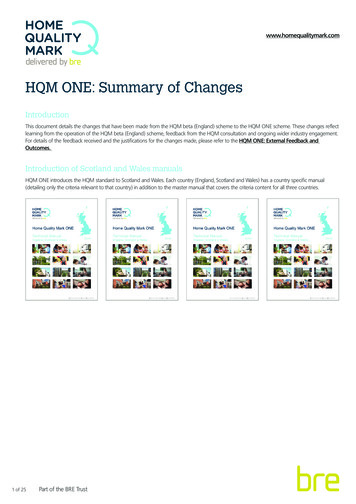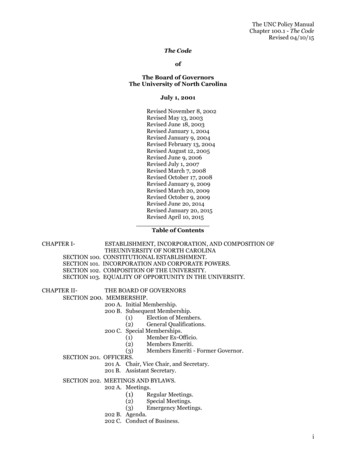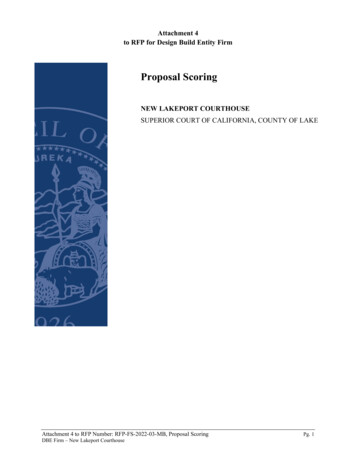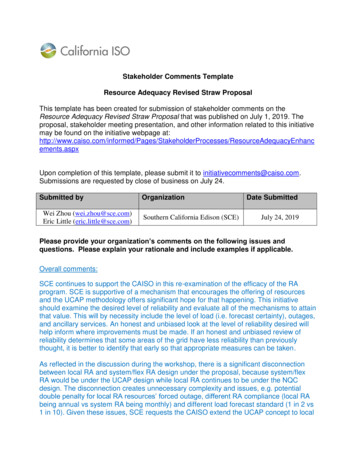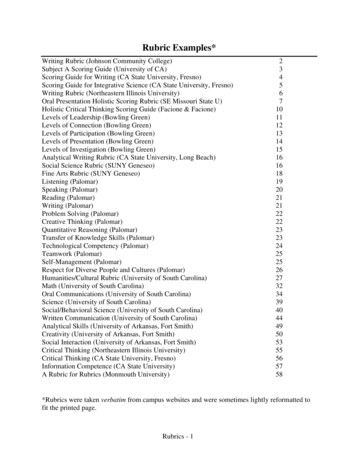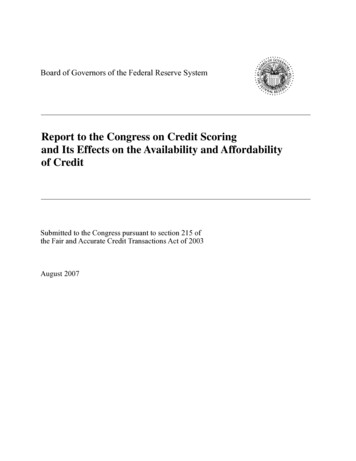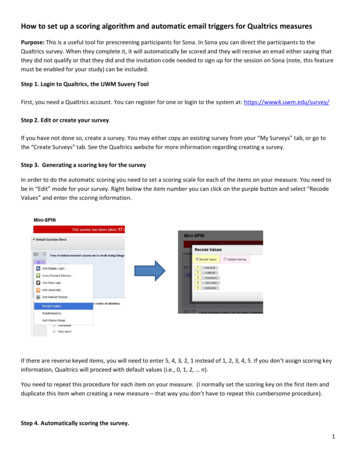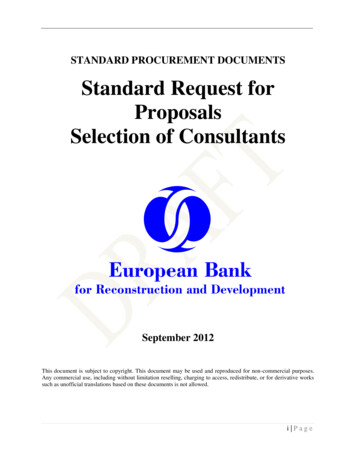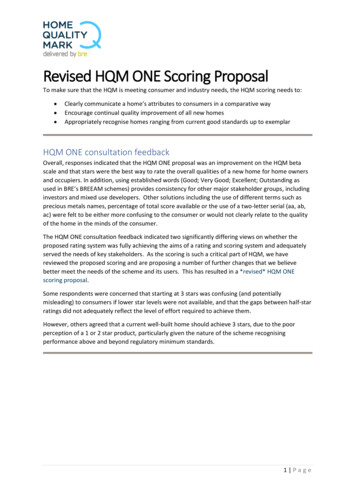
Transcription
Revised HQM ONE Scoring ProposalTo make sure that the HQM is meeting consumer and industry needs, the HQM scoring needs to: Clearly communicate a home’s attributes to consumers in a comparative wayEncourage continual quality improvement of all new homesAppropriately recognise homes ranging from current good standards up to exemplarHQM ONE consultation feedbackOverall, responses indicated that the HQM ONE proposal was an improvement on the HQM betascale and that stars were the best way to rate the overall qualities of a new home for home ownersand occupiers. In addition, using established words (Good; Very Good; Excellent; Outstanding asused in BRE’s BREEAM schemes) provides consistency for other major stakeholder groups, includinginvestors and mixed use developers. Other solutions including the use of different terms such asprecious metals names, percentage of total score available or the use of a two-letter serial (aa, ab,ac) were felt to be either more confusing to the consumer or would not clearly relate to the qualityof the home in the minds of the consumer.The HQM ONE consultation feedback indicated two significantly differing views on whether theproposed rating system was fully achieving the aims of a rating and scoring system and adequatelyserved the needs of key stakeholders. As the scoring is such a critical part of HQM, we havereviewed the proposed scoring and are proposing a number of further changes that we believebetter meet the needs of the scheme and its users. This has resulted in a *revised* HQM ONEscoring proposal.Some respondents were concerned that starting at 3 stars was confusing (and potentiallymisleading) to consumers if lower star levels were not available, and that the gaps between half-starratings did not adequately reflect the level of effort required to achieve them.However, others agreed that a current well-built home should achieve 3 stars, due to the poorperception of a 1 or 2 star product, particularly given the nature of the scheme recognisingperformance above and beyond regulatory minimum standards.1 Page
Feedback analysisInitial analysis was carried out on the HQM feedback received, in relation to HQM beta and theconsultation draft of HQM ONE, to identify parts of the proposed scoring that worked well, andthose parts that required further adaptation. This resulted in the following proposals for a *revisedHQM ONE scoring proposal*:ProposalsChangeStart star rating on a scale from 1 to 5(with 1 star awarded to homes formeeting HQM’s baseline requirementsand 5 stars awarded to homes that areoutstanding)RetainHalf star incrementsJustification Removes potential for consumer confusion Recognises the current level of improvement overthe HQM baseline (minimum requirements) in a waythat is accessible to consumers.Retain3-star score as broadly equivalent to awell designed and built Code Level 3homeRetain5-star score (i.e. 80%, or 400 credits) Increases scoring granularity to recognise a broaderrange of performance beyond minimum standardsand in between HQM star ratings (i.e. increasing thescale from 5 - to 9 steps; 1, 1.5, 2, 2.5, 3, 3.5, 4, 4.5,5)Maintains previous entry level score at an outputlevel that is acceptable to industry and consumersAllows for certification of lower scoring homeswhere requiredMaintains score required for an ‘outstanding’ home,to recognise exemplar projects and continually pushstandards higher.Having identified the above key points, it was necessary to establish specific benchmarks for each ofthe proposed 9 steps in the ratings that encourage improvement in performance over time. Theintroduction of additional star ratings, combined with the need to keep the 3-star score consistentwith the HQM ONE consultation proposals, meant that an appropriate benchmark scale wasrequired for both sides of the 3-star level (i.e. for 1-3 star, and for 3-5 star).In summary we are proposing to set the 1 star entry at a level that represents a home whichachieves the minimum HQM requirements only, as these are considered critical to the delivery ofany quality home.2 Page
To identify an appropriate benchmark scale for the remaining star levels, a series of scenarios(covering a range of good to best practice standards) were modelled within the HQM ONE scheme.This modelling identified further changes to scoring principles:ProposalsIntroduce1-star for achieving minimumrequirements onlyChangeBenchmark scale from staggered toprogressiveRetain3-star score (i.e. 30%, or 150 credits)Justification Emphasises these as the baseline entry requirementsfor the scheme Encourages continual improvementReduces improvement requirements at lower levels Broadly, a well designed and built Code Level 3home was achieving this score in HQM ONE(assuming all minimum requirements were met)Scenario modellingTo establish an appropriate benchmark range, over twenty scenarios were modelled against theHQM ONE scheme. To do this, a series of assumptions were made: the minimum requirements were metconservative judgements regarding issues relating to locationconservative assessment against the criteria intention where detail was lacking or subjective*new* issues or criteria that were not considered standard practice were not assumed asachievedStatistical analysis was completed on the results from the scenario modelling to help inform specificbenchmark figures.The results from the modelling suggested that the progressive benchmark scale, illustrated in thegraph below (light blue line), would best reflect the outcomes (note that these have been displayedagainst the staggered HQM beta and HQM ONE consultation benchmark scales, for reference).HQM Benchmark Scales50045040035030025020015010050011.5HQM beta22.53HQM ONE consultation3.544.55HQM ONE *revised*3 Page
This progressive benchmark scale also addressed the concerns raised regarding the difficulty ofachieving a half star increase by: reducing the credit score required at each star rating up to 4.5 starreducing the improvement required between star ratings up to 4.5 starThe *revised* proposalHaving established an appropriate benchmark scale, the *revised* HQM ONE scoring proposal forthe star and indicator scores is summarised below:Star RatingMinimum requirements 8%24048%Very Good30060%Excellent40080%OutstandingScore RequiredDescriptorCertifiedGoodIndicator LevelsPercentageRequired18%20%30%48%80%Each star rating will be accompanied by a descriptive term to help contextualise the overall rating forthe consumer. The 3 star level (i.e. a well designed and built Code Level 3 home) was considered theminimum rating at which to apply a positive descriptor as this represents typical practice acrossmuch of the housing sector. The descriptors used for 3 to 5 star ratings also allow for a high level ofcomparison between HQM and other standards within the BREEAM family of schemes.It is proposed that the indicator levels (1 to 5) follow the same progressive benchmark scale as thestars, albeit with fewer levels. Their percentage requirements align with the respective whole stars.Indicator level 1 will be the only exception, which will link with the percentage requirements for 1.5star (as it is not a requirement of 1 star to achieve any tradable credits).4 Page
What’s next?Through increased granularity of the star ratings and amended benchmarking of both the stars andindicators, we believe that the *revised* HQM ONE scoring proposal addresses the concerns raisedthrough the feedback, and ensures the scheme meets the needs identified at the beginning of thisdocument. However, to fully understand whether this has been achieved, we need to test how theproposed scoring works in practice.To find out how you can get involved, please go up.5 Page
HQM ONE consultation feedback Overall, responses indicated that the HQM ONE proposal was an improvement on the HQM beta scale and that stars were the best way to rate the overall qualities of a new home for home owners and occupiers. In addition, using established words (Good; Very Good; Excellent; Outstanding as
